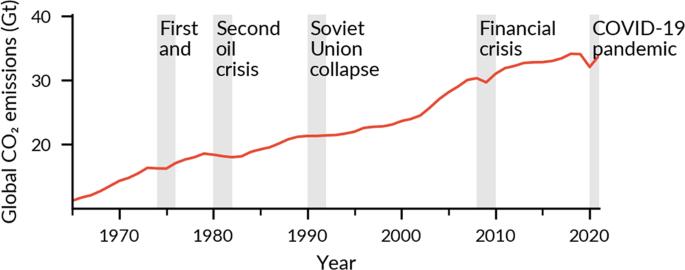Most industrialised countries have peaked carbon dioxide emissions during economic crises through strengthened structural change
IF 8.1
1区 地球科学
Q1 ENVIRONMENTAL SCIENCES
引用次数: 0
Abstract
As the climate targets tighten and countries are impacted by several crises, understanding how and under which conditions carbon dioxide emissions peak and start declining is gaining importance. We assess the timing of emissions peaks in all major emitters (1965–2019) and the extent to which past economic crises have impacted structural drivers of emissions contributing to emission peaks. We show that in 26 of 28 countries that have peaked emissions, the peak occurred just before or during a recession through the combined effect of lower economic growth (1.5 median percentage points per year) and decreasing energy and/or carbon intensity (0.7) during and after the crisis. In peak-and-decline countries, crises have typically magnified pre-existing improvements in structural change. In non-peaking countries, economic growth was less affected, and structural change effects were weaker or increased emissions. Crises do not automatically trigger peaks but may strengthen ongoing decarbonisation trends through several mechanisms. In most developed economies where decarbonisation processes are already in place, economic crises have coincided with a peak and subsequently declining emissions as a result of lower carbon and energy intensities, according to a statistical analysis of 45 countries between 1965 and 2019.

大多数工业化国家通过加强结构改革,在经济危机期间使二氧化碳排放量达到峰值
随着气候目标的收紧和各国受到多次危机的影响,了解二氧化碳排放如何以及在何种条件下达到峰值并开始下降变得越来越重要。我们评估了所有主要排放国达到排放峰值的时间(1965-2019 年),以及过去的经济危机在多大程度上影响了导致排放峰值的排放结构性驱动因素。我们发现,在 28 个达到排放峰值的国家中,有 26 个国家的排放峰值出现在经济衰退之前或期间,原因是危机期间和之后经济增长较低(中位数为每年 1.5 个百分点)以及能源和/或碳强度下降(0.7)的综合影响。在峰值和衰退期国家,危机通常会放大结构变化中已有的改善。在非英语国家,经济增长受到的影响较小,结构变化效应较弱或增加了排放。危机不会自动触发峰值,但可能通过几种机制加强正在进行的去碳化趋势。根据对 1965 年至 2019 年间 45 个国家的统计分析,在大多数已开展去碳化进程的发达经济体中,经济危机与排放峰值同时出现,随后由于碳和能源强度降低而导致排放下降。
本文章由计算机程序翻译,如有差异,请以英文原文为准。
求助全文
约1分钟内获得全文
求助全文
来源期刊

Communications Earth & Environment
Earth and Planetary Sciences-General Earth and Planetary Sciences
CiteScore
8.60
自引率
2.50%
发文量
269
审稿时长
26 weeks
期刊介绍:
Communications Earth & Environment is an open access journal from Nature Portfolio publishing high-quality research, reviews and commentary in all areas of the Earth, environmental and planetary sciences. Research papers published by the journal represent significant advances that bring new insight to a specialized area in Earth science, planetary science or environmental science.
Communications Earth & Environment has a 2-year impact factor of 7.9 (2022 Journal Citation Reports®). Articles published in the journal in 2022 were downloaded 1,412,858 times. Median time from submission to the first editorial decision is 8 days.
 求助内容:
求助内容: 应助结果提醒方式:
应助结果提醒方式:


